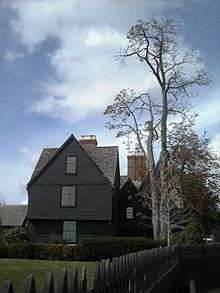Joseph Everett Chandler
Joseph Everett Chandler (December 11, 1863 – August 19, 1945) is considered a major proponent of the Colonial Revival architecture.[1]

Biography
Joseph Everett Chandler was the son of a butcher. He grew up driving carriage-loads of tourists around Plymouth to see its sites.[2]
Chandler attended the Massachusetts Institute of Technology (M.I.T.) and was an apprentice of McKim, Mead & White, Charles Howard Walker, William Pretyman, Burnham and Root, and Rotch & Tilden.[2]
He is considered a pioneering designer of queer space. He designed Red Roof for A. Piatt Andrew, which inspired interior designer Henry Davis Sleeper to build his own Beauport next door.[2]
Career
Chandler is mostly known to have overseen the restoration of the Paul Revere House and the House of Seven Gables.[3] He worked with George Warren Cole.[2]
With George Francis Dow, he conceived Pioneer Village (Salem, Massachusetts) as a means to demonstrate life in 1630.[4][5]
In 1892 he published The Colonial Architecture of Maryland, Pennsylvania, and Virginia and in 1916 The colonial house with R.M. McBride & company.[6]
Works
- 1898: designed The Frederic C. Adams Public Library, an historic library building at 33 Summer Street in Kingston, Massachusetts. The library was added to the National Register of Historic Places in 2001.[1]
- 1898: restored the Isaac Royall House.[7]
- 1900s: restored The Old Farm, an historic First Period house at 9 Maple Street in Wenham, Massachusetts. The restoration job was the subject of an article in a 1921 edition of House Beautiful.[8] The house was listed on the National Register of Historic Places in 1990.[1]
- 1902: restored the Paul Revere House.[7]
- 1902: designed Red Roof for A. Piatt Andrew (demolished)
- 1909: designed the Wright Memorial Library. Georgianna Wright (1837–1919) hired Chandler to design a brick library in the colonial revival style.[9] It was listed on the National Register of Historic Places in July 2007.[1]
- 1908 to 1910: restored the House of the Seven Gables.[10]
- 1913: designed Marsh Room, the double-height hall of the Harvard Musical Association, of which Chandler was a member.
- 1914 to 1918: remodeled two late-Federal period farmhouses to become The Stevens–Coolidge Place. Also enhanced the design of the landscape, which eventually included a perennial garden, a kitch and flower garden, and a rose garden (all in the Colonial Revival style).[11]
- 1921: restored the Harlow Old Fort House. In 1974 the house was added to the National Register of Historic Places.[1]
- 1933: designed The Ballou-Newbegin House, an historic house on Old Marlborough Road in Dublin, New Hampshire. The house was listed on the National Register of Historic Places in 1983.[3]
References
- "National Register Information System". National Register of Historic Places. National Park Service. April 15, 2008.
- Timothy Orwig, "Joseph Everett Chandler, Colonial Revival Architecture, and the Origins of Historic Preservation in New England"
- "National Register Information System". National Register of Historic Places. National Park Service. July 9, 2010.
- North of Boston Convention & Visitors Bureau. "George Francis Dow". Archived from the original on July 10, 2011. Retrieved February 22, 2011.
- Goff, J. '(March 21, 2008) A landmark year: Milestones marked for Pioneer Village, the Arbella and more Salem Gazette. p.4.
- Joseph Everett Chandler. The colonial house, rev. ed. R.M. McBride & company, 1916
- "National Register Information System". National Register of Historic Places. National Park Service. January 23, 2007.
- "NRHP nomination for Old Farm". Commonwealth of Massachusetts. Retrieved 2014-01-12.
- Browne, Patrick T.J.; Forgit, Norman (2009). Duxbury...Past & Present. The Duxbury Rural and Historical Society, Inc. p. 20. ISBN 0-941859-11-8.
- North Shore Community College. "Hawthorne in Salem: Images Related to the Turner-Ingersoll House, aka "The House of the Seven Gables"". Retrieved 2006-05-31.
- Forsyth, Holly Kerr. Gardens of Eden: Among the World's Most Beautiful Gardens. Carlton, Vic.: Miegunyah Press, 2009, p. 131-132.